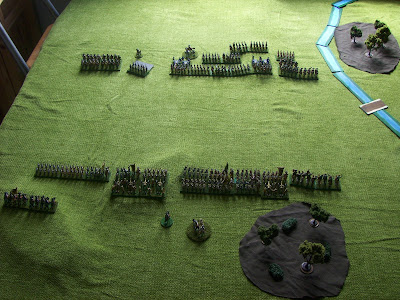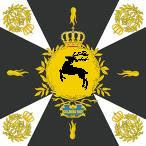
The war is on! Strathia is up against an alliance of three enemy states, and the Duke Von Halburg himself is poised to invade Meldenia with the main army of the Duchy. To the south however, the secondary army is waiting under Count Von Stresswitz, guarding the main city of Palmsa from the Sarvanian Army (the two lower army markers you can see facing off against each other on the map above.) Sarvania duly advances, unable to resist the chance to put all of Strathia's plans into chaos by forcing a siege on their capital so rapidly in the war.
 The white-coated Sarvanians enter the filed of battle from the bottom of the picture, while the blue wall of Strathians wait silently for them - both flanks anchored on a small village and a stream on each side of them. There's only one route for the Sarvanians to take - headlong!
The white-coated Sarvanians enter the filed of battle from the bottom of the picture, while the blue wall of Strathians wait silently for them - both flanks anchored on a small village and a stream on each side of them. There's only one route for the Sarvanians to take - headlong!
 The Sarvanian infantry attacks in double-ranks, keeping its Grenadiers and lively Hungarian-style regiments to the fore. On the open flank, the Sarvanians move artillery up and a screen of infantry, thus bringing the village under bombardment and blocking the superior Strathian cavalry.
The Sarvanian infantry attacks in double-ranks, keeping its Grenadiers and lively Hungarian-style regiments to the fore. On the open flank, the Sarvanians move artillery up and a screen of infantry, thus bringing the village under bombardment and blocking the superior Strathian cavalry.
 Kapow! After enduring a hail of incoming cannon-balls, the Sarvanian line hits home. The bluecoat Strathians reel back, with some units cracking up under the strain and fleeing for the rear as the Hungarians press home and threaten to put their swords & bayonets to use.
Kapow! After enduring a hail of incoming cannon-balls, the Sarvanian line hits home. The bluecoat Strathians reel back, with some units cracking up under the strain and fleeing for the rear as the Hungarians press home and threaten to put their swords & bayonets to use.
 The fight goes on, but bogs down. Count Stresswitz keeps a steady hand on things and rallies waverers, plus sends reserves in as required to blunt the Sarvanian attack.
The fight goes on, but bogs down. Count Stresswitz keeps a steady hand on things and rallies waverers, plus sends reserves in as required to blunt the Sarvanian attack.

General Von Kreist, Reichskanzler of Sarvania, has had a pretty good day by his standards. His obligations to the League are fulfilled, and the strength of the Strathian military whittled down a fair degree - as are his own. True, some might say he just did the bare minimum and then retreated, or that his attack was beaten back, but what do they know? The Strathian position was a tough one, and the slippery Count still had his grenadiers in reserve - clearly no decision of decisive nature was going to be reached, and in the best traditions of 18th-Century Military Theory are clear: bst to withdraw and count on the damage done collectively adding up. Now, all eyes in the region turn northwards to the anticipated Strathian invasion of Meldenia...
[A quick word on forces in the campaign: The Strathian army is huge, and by points-standards it is as large as the other three allied armies added together. However, as the other three countries can rebuild every year in normal DBA-Campaign style, the Strathian Player can't. His large army will, in a protracted war, be ground down until it also reaches the same size as any other participant, when it will then recruit normally. If The Duke of Strathia fancies remaining the regional top-dog, he'll have to do it fast!]


